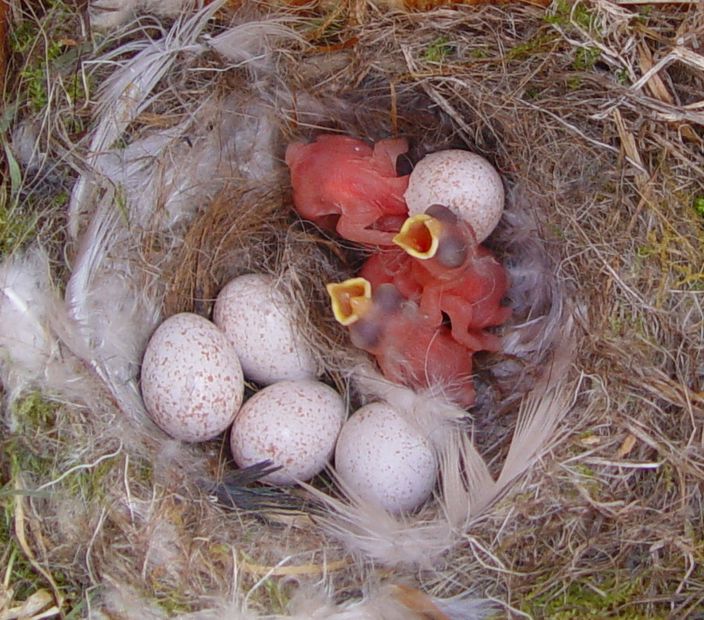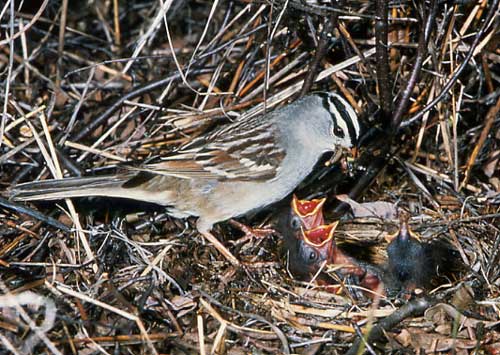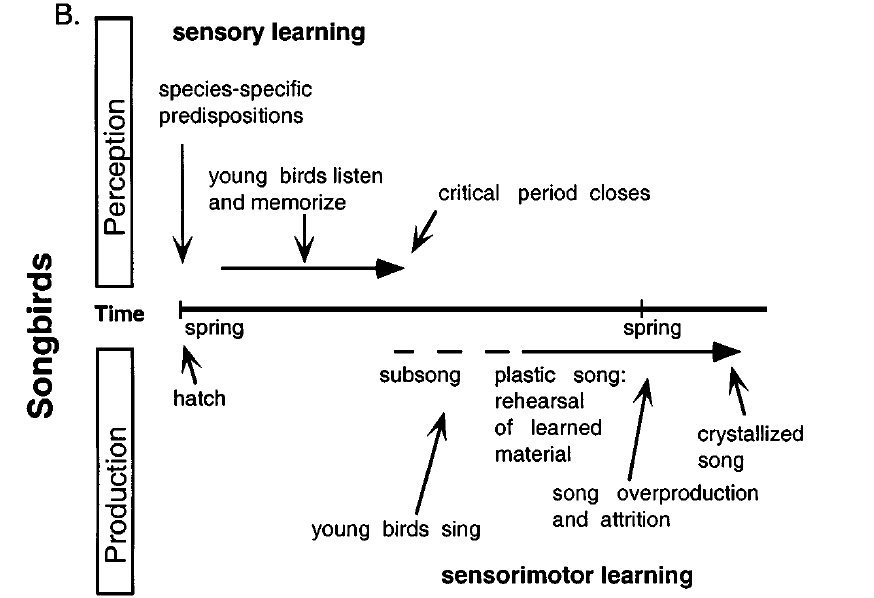Songbird Signalling Behavior: Duetting
Biology 342 Fall 2010
Ontogeny
Bird song development is a culmination of many different factors and is a highly species specific phenomena.
Critical Period
Every species of song bird must initially go through a critical period. The critical period can be can be explained as a window of opportunity for vocalization acquisition. This window is species specific, for example in the white crowned sparrow the window is about 20 -100 days after hatching. If a chick is put in auditory isolation 5-14 days after hatching, it will lack dialectic characteristics of its conspecific population. Thus, the song will be a composite of random vocalizations unique the native the population it was initially isolated from. When isolated later in development at 20 to 100 days with a live tutor, however, the full song will develop. On the other hand if the same young birds are reared with merely an audio recording of adult conspecifics no song will develop (Marler). Thus in the white crowned sparrow, song acquisition is limited to direct contact with adult conspecifics in the first 100 days of life.

(Image courtesy of http://personal.ee.surrey.ac.uk/Personal/D.Jefferies/bird/diary2003.html)
Although this general trend is exhibited in many song bird species, every species has specifics not displayed in other species. In Fringilla coeless the critical period is in the first 10 months of a prospective 5 year life span. If a Chaffinch is trapped roughly 4 months after hatching in the fall and reared in audacitic isolation, it will develop a close replica of song patterns present in its conspecific population. Thus, the most integral period in song development for Chaffinches is in the first 4 months where hatchlings hear and memorize parental song patterns. Consequently, song is developed from adult conspecifics, and, after a year, the song becomes stereotypical and stable. If a 3 month old Chaffinch is deafened it will produce patterns similar only to fledglings. Therefore full song in Chaffinches is dependent not only on adult conspecifics but also on auditory feedback at an early age (Nottenbaum) . In Laniarius aethiopicus song development is even more complex because it is a duetting species. In experiments done by Wickler and Sonneschein, the authors showed that the critical period for this species is 5 to 14 days. When isolated after this time frame, even in auditory isolation from adult conspecifics, fledglings will develop full song which resembles the vocalizations from its natal area. However the most interesting aspect of this acquisition lies in the development of song after the critical period.

(Image courtsey of thecanadasite.com/art/art55_brooks.html)
If isolated with a recording of adult conspecifics, no song will develop (Marler). Thus in the white crowned sparrow, song acquisition is limited to direct contact with adult conspecifics in the first 100 days of life. Although this general trend is exhibited in many song bird species, every species has specifics not displayed in other species. In Fringilla coeless the critical period is in the first 10 months of a prospective 5 year life span. If a Chaffinch is trapped after in the fall roughly 4 months after hatching and reared in audacitic isolation, it will develop a close replica of song pattern present in the population it was isolated from. Thus, the most integral period in song development for Chaffinches is in the first 4 months where hatchlings hear and memorize parental song patterns. Consequently, song is developed from adult conspecifics and, after a year, the song becomes stereotypical and stable. If a 3 month old Chaffinch is deafened, it will only produce patterns similar to fledglings. Therefore full song in Chaffinches is dependent not only on adult conspecifics but also on auditory feedback at an early age (Nottenbaum) . In Laniarius aethiopicus song development is even more complex because this is a duetting species. In experiments done by Wickler and Sonneschein, they showed that the critical period is 5 to 14 days. When isolated after this time frame, even in auditory isolation from adult conspecifics, fledglings will develop full song which resembles the vocalizations from its natal area. However, the most interesting aspect of this acquisition lies in the development of song after the critical period.
Song Devepolment

(Courtsey of Doupe, Allison and Kuhl (1999))
After the critical period, song development can be broken into three major stages: subsong, plastic song, and full song. This can be seen in the figure displayed above. Subsong has the characteristics of fledgling hunger cries and plastic song includes characteristics of full song but lacks well defined phrases or overall stability. In Laniarius aethiopicus or African Boubous males develop song the closely resembles or completely resembles the rearing adult male conspecific (Grafe). Interestingly, however, males often incorporate at least one element of the female song into their repertoire as it is heard in the duet. In effect this creates an entirely new vocalization because the fledglings capture a piece of the adult conspecifics' conversation and incorporates it into his normal individual full song. Females in this species tend to incorporate aspects of both the male and female parts of the duet into her full song almost equally, not showing the same discrepancy that male fledglings show (Grafe). In non-duetting species, such as Fringilla coeless, after full song is established, it becomes a highly stereotyped pattern that will not change in subsequent years that is an exact copy of the respective gendered adult conspecific's. This is interesting because in non-deuting species male fledglings learn only the male conspecific full song and the same is true of female fledglings for the female conspecific full song. This, however, is not apparent in duetting species (Nottenbaum). Of course there is an exception to this rule of the non-duetting species, the Amazona amazonica which through out iife will integrate new vocalizations into its full song.